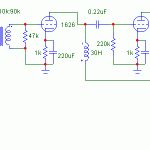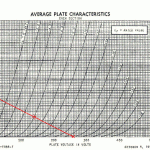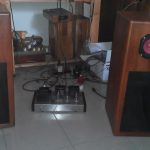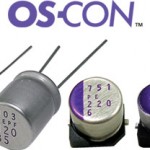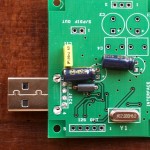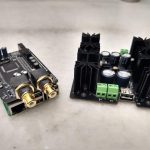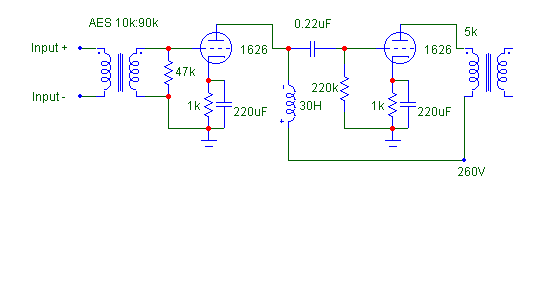Great stuff that don’t cost a bomb.
Part recommendation: AES PT-156 interstage transformer
A little about me. I like audio. I like DIY and I get a lot of kick out of beautiful expensive sound with little $$ outlay. Sure any idiot can build an amp with the likes of Black Gates, Audio Notes, Tamuras blah blah blah but the real challenge lies in replicating the performance with down-to-earth parts (and prices). Cheap I may be, but hey, we live in a real world, OK? where not everyone can afford expensive audiophile-approved parts. Nevertheless, what is DIY if you don’t aim for the sky?
Inspired by the philosophy behind Mr. Sakuma’s work, I began to develop an interest in interstage transformers. I haven’t had the opportunity to listen an amplifier with interstage trannies yet so the next best thing would be to… build one myself. I then checked out the prices of interstage and… it hurts. Deeply.
We are talking about at least US100 per iron and since we need 2 for stereo, this already cost more than my Darling amp! Goodness gracious! If I were to splurge on these, what am I going to eat for the rest of the month?!
But Bob Danielak’s Sakuma Darling uses the much much cheaper Antique Electronic Supply PT-159 interstage. At ~US15 each, what more can I ask for?
So I placed my order and they duly arrived at my workplace.
Since they were already at my workplace, buddy YH suggested, why not test them? Great idea. I’m eager to see the frequency response too as AES doesn’t have any.
Hooked up to a waveform generator, oscilloscope and the fun begins. Since I intend to use this interstage directly from the CD player, the waveform generator’s internal impedance of 50ohm is pretty similar. On the output side, I hooked a 1Mohm resistor. In parallel with the scope probe’s impedance of 1Mohm, we thus have a load of 500kohm.

Put in a sine wave and there’s a sine wave at the output. All’s well goes well but the proof of the pudding is always the square wave. This is what separates the men from the boys.
Put in a square wave and… it rings, it rings, it rings. You see a squarewave but there’s lots of ringing at the edges. Not nice. You get what you pay for right? WAIT!

500kohm load on secondary. 1kHz input.

500kohm load on secondary. 10kHz input.
I then tested its frequency response, starting from 20hz to 35kHz. Looking at it, now I know why it rings. There’s a peak at 27kHz. The interstage is resonanting at this frequency. As a result, any harmonics at this frequency will be greatly amplified. This explains the ringing. Actually, this interstage is pretty good. It’s pretty flat from 20Hz to 10kHz. It is from 10kHz that it starts to rise and peaks at about 27khz, before coming down. From a gain of ~9dB at 20Hz-10kHz, at resonant frequency, the gain is close to 25dB. No wonder those square waves are ringing.
YH then suggested, "why don’t you try different loading on the secondary? If you get this right, it’ll reduce this peak." The master has spoken and the apprentice sets forth.
Below is the graph of the PT-156 with various secondary resistive loads.
For best fidelity, for best "hi-fi", a secondary loading of 44kohm should be just nice. We are talking about +/-1dB across 20Hz to 20kHz! Please note that you could play around with the secondary resistor to peak the response a little. Let’s say your system is a bit reticent on the highs and you want more treble energy. Looking at the chart, somewhere between 44kohm and 76kohm should do. Experiment and tailor to taste.

44kohm load on secondary. 1kHz input.

44kohm load on secondary. 10kHz input.
The 10kHz waveform doesn’t look so pretty heh? Well, that’s because the frequency response is not very high. If you have a higher frequency response (say flat up to 40kHz), then you can get a prettier 10kHz waveform.
However, please note that these graphs were developed with what I have in mind. I intend to use this interstage in between my CD player and the grid of an input tube, where very very little DC current is present. Should you decide to use in an application where there’s appreciable amount of DC current, say coupling between 2 single ended tube stages, the frequency response should be different and needs to be investigated.
In other words, you got to do your homework. But hey! You can pass the savings to more CDs! (or to me!)
That’s all! As you can see, you truly get what you pay for, but with a little knowledge, a waveform generator and an oscilloscope, we can do wonders. Why heck, the above results can even be replicated with a Wein bridge oscillator and a multimeter!

